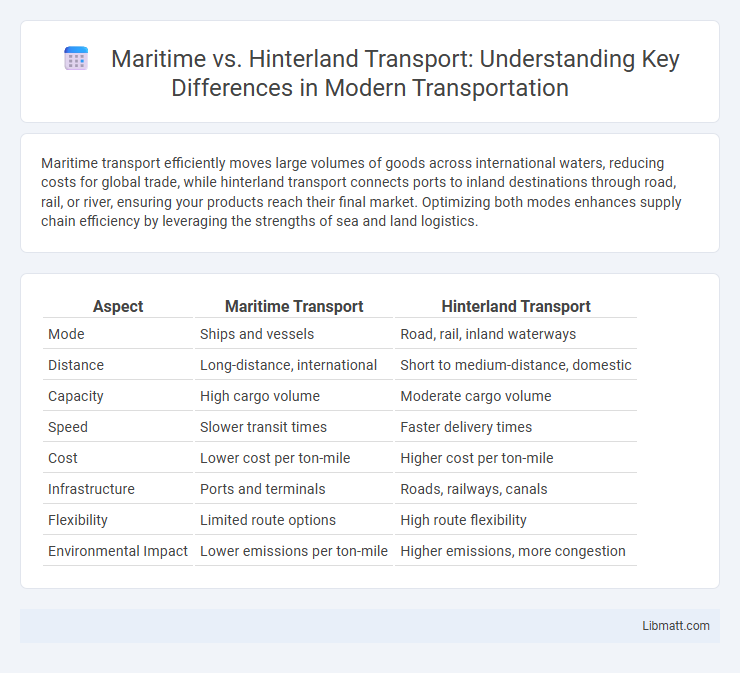Maritime transport efficiently moves large volumes of goods across international waters, reducing costs for global trade, while hinterland transport connects ports to inland destinations through road, rail, or river, ensuring your products reach their final market. Optimizing both modes enhances supply chain efficiency by leveraging the strengths of sea and land logistics.
Table of Comparison
| Aspect | Maritime Transport | Hinterland Transport |
|---|---|---|
| Mode | Ships and vessels | Road, rail, inland waterways |
| Distance | Long-distance, international | Short to medium-distance, domestic |
| Capacity | High cargo volume | Moderate cargo volume |
| Speed | Slower transit times | Faster delivery times |
| Cost | Lower cost per ton-mile | Higher cost per ton-mile |
| Infrastructure | Ports and terminals | Roads, railways, canals |
| Flexibility | Limited route options | High route flexibility |
| Environmental Impact | Lower emissions per ton-mile | Higher emissions, more congestion |
Overview of Maritime and Hinterland Transport
Maritime transport facilitates the movement of large volumes of goods across international waters, leveraging ports as critical nodes in global supply chains. Hinterland transport connects these ports to inland destinations through rail, road, and inland waterways, optimizing last-mile delivery and regional distribution. Efficient integration between maritime and hinterland networks enhances supply chain reliability, reduces transit times, and lowers overall transportation costs.
Key Differences Between Maritime and Hinterland Logistics
Maritime logistics primarily involves the transportation of bulk goods and large cargo volumes across international waters using container ships, tankers, and bulk carriers, emphasizing cost-efficiency over long distances. Hinterland logistics focuses on the movement of goods from ports to inland destinations through road, rail, and inland waterways, prioritizing speed, connectivity, and multimodal integration for last-mile delivery. Key differences include the scale and type of transport modes, the geographical scope spanning overseas versus regional networks, and the operational emphasis on port handling versus inland distribution.
Importance of Maritime Transport in Global Trade
Maritime transport handles over 80% of global trade volume, making it the backbone of international commerce due to its cost-effectiveness and capacity to move large quantities of goods across continents. Its efficiency in connecting producers and consumers worldwide surpasses hinterland transport, which primarily facilitates the distribution of goods from ports to inland destinations. Your supply chain depends heavily on maritime transport for timely and economical delivery of raw materials and finished products across global markets.
Role of Hinterland Transport in Supply Chains
Hinterland transport plays a crucial role in connecting maritime ports to inland destinations, ensuring efficient movement of goods beyond coastal areas. It facilitates seamless integration of supply chains by enabling timely distribution, reducing bottlenecks, and optimizing cargo flow from ships to warehouses and final consumers. Your supply chain reliability depends significantly on the coordination between maritime arrival schedules and hinterland transport efficiency.
Infrastructure Requirements: Seaports vs Inland Hubs
Seaports demand extensive maritime infrastructure such as deep-water berths, container cranes, and navigational aids to accommodate large ocean vessels and facilitate efficient loading and unloading. Inland hubs require robust multimodal connections including rail terminals, highways, and warehousing facilities to ensure seamless distribution and integration with hinterland transport networks. Efficient coordination between seaport terminals and inland hubs is critical to optimizing the supply chain and minimizing logistical delays.
Cost Comparison: Maritime vs Hinterland Transport
Maritime transport generally offers lower costs per ton-mile compared to hinterland transport due to the ability to move large volumes over long distances efficiently, benefiting from economies of scale. Hinterland transport, such as trucking or rail, tends to have higher costs related to fuel, labor, and infrastructure maintenance, especially for smaller loads or shorter distances. Your choice between maritime and hinterland transport should consider these cost differences alongside factors like speed, flexibility, and last-mile delivery requirements.
Environmental Impact: Sea Routes vs Land Corridors
Maritime transport generally produces lower greenhouse gas emissions per ton-mile compared to hinterland transport due to the high cargo capacity and fuel efficiency of ships. However, hinterland transport, primarily using trucks and trains, often results in increased air pollution and carbon emissions because of frequent stops and smaller payloads. To minimize your supply chain's environmental impact, leveraging sea routes for long-distance bulk shipments and optimizing land corridors for last-mile delivery is essential.
Efficiency and Speed in Maritime and Hinterland Transport
Maritime transport offers high efficiency for bulk and long-distance shipments due to larger cargo capacity and lower fuel consumption per ton, making it ideal for cost-effective international trade. Hinterland transport, often relying on road and rail networks, provides faster door-to-door delivery and better accessibility to inland destinations, ensuring timely distribution. Optimizing your supply chain requires balancing maritime speed with hinterland transport's flexibility to enhance overall efficiency.
Technological Innovations in Maritime and Hinterland Sectors
Technological innovations in maritime transport include advanced navigation systems, autonomous vessels, and digital twin technology that enhance efficiency and safety at sea. In contrast, hinterland transport benefits from smart logistics platforms, automated freight handling, and real-time tracking systems, improving cargo flow and reducing transit times. Your supply chain can achieve optimal integration and seamless connectivity by leveraging cutting-edge technologies across both maritime and hinterland sectors.
Future Trends in Integrated Maritime-Hinterland Transport
Future trends in integrated maritime-hinterland transport emphasize enhanced digitalization and automation to improve efficiency and reduce transit times. The expansion of smart ports with advanced IoT systems allows seamless data exchange between maritime terminals and hinterland logistics networks, optimizing container flow and minimizing congestion. Your supply chain will benefit from increased collaboration among stakeholders, fostering sustainable and resilient transport corridors that integrate rail, road, and inland waterways for seamless connectivity.
maritime vs hinterland transport Infographic

 libmatt.com
libmatt.com